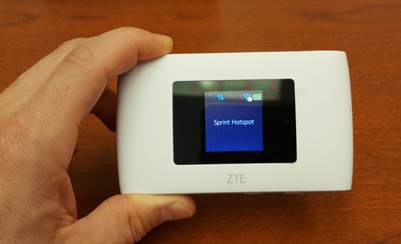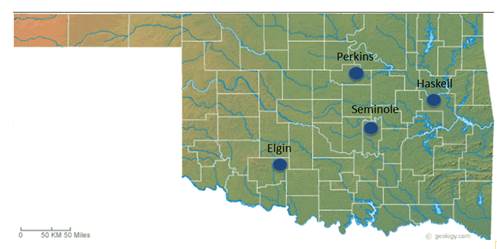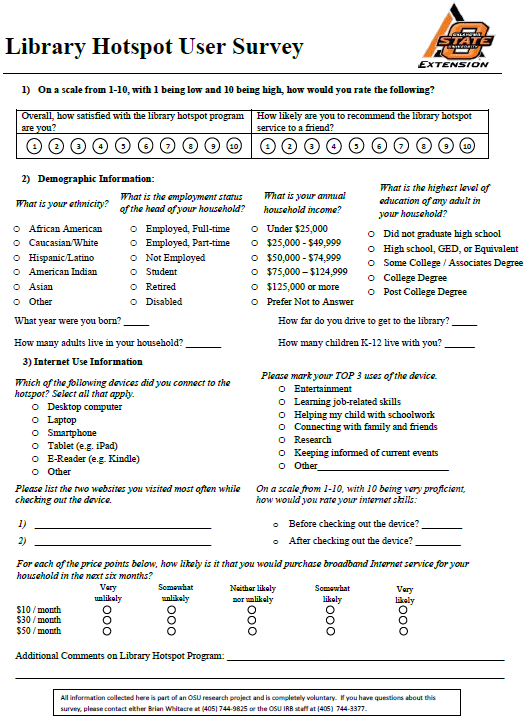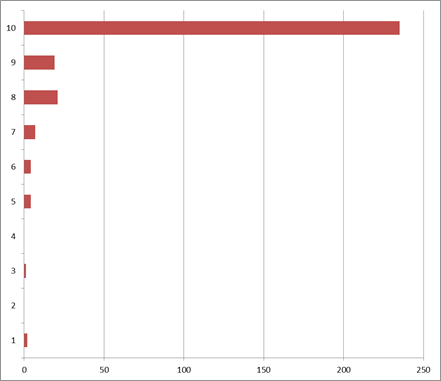 |
April 2019
|
April 2019 // Volume 57 // Number 2 // Feature // v57-2a2
Building a Rural Library Hotspot Lending Program: Results from a One-Year Pilot
Abstract
In today's society, individuals and households without reliable Internet connections are increasingly at risk of facing significant disadvantages. This article describes an Extension-led pilot project in Oklahoma centered on addressing this issue through the establishment of a hotspot lending program in four rural libraries. Through the program, libraries allow patrons to "check out the Internet" by providing cellular-based hotspots that connect to a user's smartphone, tablet, or laptop. Feedback from librarians and 297 survey respondents suggests that the program is highly popular and is reaching the target audience. Conclusions on barriers faced and suggestions for best practices, including the role Extension can play, are provided.
Introduction
Broadband Internet access has become an important topic for Extension educators across the country. Researchers have explored whether Extension should focus on demand or supply-side issues (Whitacre, 2008), how small businesses use the Internet (Gallardo & Jacobs, 2014), how Extension might focus on Internet use to improve rural residents' access to health information (Das, Leatherman, & Bressers, 2015), and how developing online material could help Extension improve its outreach capabilities (Green, 2012; Woods & Langcuster, 2014). As Internet access and use becomes increasingly intertwined with many aspects of life, Extension personnel likely will be interested in efforts to improve access for disadvantaged households.
There are very real concerns that individuals and households without reliable Internet connections are at a disadvantage. This has come to be known as the "digital divide"—differences in broadband access (and use) across various segments of society. Forms of digital divide have been identified in terms of rural versus urban residents (Whitacre, Strover, & Gallardo, 2015), low-income versus high-income households (Anderson, 2017), and younger versus older individuals (Wu, Damnee, Kerherve, Ware, & Rigaud, 2015). Research from Pew Research Center has suggested that most adults view a lack of broadband as being a major disadvantage with regard to activities such as finding out about new jobs, learning about government services, getting health information, or keeping up with news and information (Horrigan & Duggan, 2015). One notable area associated with this subject is the "homework gap," whereby students in kindergarten through grade 12 who do not have Internet connection at home often fall behind their counterparts who benefit from constant access (McLaughlin, 2016).
The response to these concerns has come from a variety of directions, including federal, private-sector, and local efforts. The federal government has grant and loan programs to address the lack of infrastructure in many rural areas (Kruger & Gilroy, 2016). The federal Lifeline phone service program was expanded to include broadband access as an allowable expenditure in 2016; qualifying customers can now receive a $9.25 monthly subsidy for broadband service (Federal Communications Commission [FCC", 2016). Some Internet companies have introduced programs for low-income consumers, with prices as low as $5 or $10 per month for a wired connection (Whitacre, 2016). Organizations such as the National Digital Inclusion Alliance work to promote digital inclusion programs, including partnerships with city governments, nonprofits, and libraries (Callahan, Crocker, & Siefer, 2018).
Libraries are particularly important partners for digital inclusion work. Nearly all libraries offer free access to computers and broadband Internet in their physical spaces, and most also offer a range of free technology instruction and help for individuals in creating resumes and searching for jobs online (Information Policy and Access Center, 2015). Some research has even shown a link between the presence of a library and higher local home broadband adoption rates, but only in rural counties (Whitacre & Rhinesmith, 2015). While all these library activities are important for addressing the digital divide, they require the patron to travel to and use the resources in the library itself, and research has shown that this "away from home" technology use is not the same as having the technology available within one's home (Connaway, 2015).
One recent shift in how libraries can influence the digital divide is the rapid growth in hotspot lending programs. Initiated by the Chicago and New York public library systems in 2014 and 2015, respectively, these programs loan out hotspot (or Wi-Fi) devices—which connect to a local cellular network—and allow patrons to use them in their homes, on the road, or anywhere the network has service (Williams, 2015). An example of a hotspot device is shown in Figure 1. Patrons check out the devices for a loan period specified by the library, typically 1 to 2 weeks, and use them to connect their own smartphones, tablets, or other devices; typically, up to 10 devices can be connected to one hotspot. Although these programs have gained traction in many urban cities, such as Detroit, New York, Seattle, and Tulsa, they are relatively unknown in most rural areas. However, such programs may be particularly useful in more remote locations as rural areas have lower availability of wired broadband (FCC, 2018a) and lower household broadband adoption rates (Perrin, 2017). Thus, establishing these programs in rural locations could be an important tool for helping bridge the rural–urban digital divide.
Figure 1.
Example Hotspot Device

To address the issue of lack of broadband access in rural areas of Oklahoma, a team of Oklahoma State University Extension personnel (of which I was a member) partnered with four small rural libraries in the state to develop a pilot hotspot lending program during 2017–2018. This pilot program, through which we provided between four and seven hotspots to each library, allowed patrons to "check out the Internet" to the comfort of their own homes. Herein I provide background on how the pilot project started, list the research questions we sought to answer, and discuss the results of our yearlong project.
Background and Research Questions
The first personal Wi-Fi devices, known as "Mi-Fis," were released by Verizon around 2009 (Pogue, 2009). Their importance was quickly recognized, and the nonprofit Mobile Beacon was created in 2010 with a focus on providing service to community anchor institutions such as libraries and schools (Mobile Beacon, 2018). Large urban libraries began loaning the devices in 2014 (Chicago) and 2015 (New York, where 10,000 of them were lent for a full year!). The funders of the New York program also were interested in how the idea might work in more rural locations and coordinated with the state library systems in Kansas and Maine to set up smaller scale projects during 2015 (Kansas State Library, 2016). In Kansas, 18 rural libraries loaned out 95 devices over 2,750 times during 2015. These results were further investigated by researchers (including through site visits to all 18 Kansas libraries) as part of an Institute of Museum and Library Services (IMLS) grant in 2016–2017 (Institute of Museum and Library Services, 2016).
Work on this IMLS grant led to the hypothesis that similar systems could be set up in other rural libraries in a relatively low-cost manner. With buy-in and roughly $3,200 in funding from the Oklahoma State Cooperative Extension Service, we began our pilot project with the following specific research questions:
- What are the main barriers libraries face when setting up such a program on their own, and what is Extension's role?
- What is the patron/community response to such a program?
- Will the project reach the intended audience (disconnected lower-income and lower-educated households) across age and racial categories?
- How many devices does a rural library need? How many loans are typical?
- Will libraries be able to maintain the program after their 1 year of funding runs out?
With these questions in mind, we developed partnerships with four rural libraries by contacting county educators and reaching out to various head librarians to gauge their interest. We believed it was better to work with a known entity already engaged in connectivity and digital literacy issues than to attempt to loan the devices from county Extension offices. Although we contacted a variety of wireless providers about working with us to provide cellular service for the program, the best price we could garner was through Mobile Beacon. Mobile Beacon is a 503(c)(3) organization and is the second largest national provider of educational broadband service in the United States (Mobile Beacon, 2018). The organization offered $80 hotspots and unlimited data for $10 per month (roughly $200 per device per year). Thus, we limited our pilot project to libraries in areas that were served by Mobile Beacon's provider. In May 2017, we ordered 16 hotspots and 1 year of unlimited data service and delivered four devices to each of the four libraries (Figure 2, Table 1). The libraries were responsible for setting their own policies and user agreements. We asked for two specific things from the libraries: (a) that each patron complete a survey (cleared by Oklahoma State University Institutional Review Board) upon return of the device (Figure 3) and (b) that each library try to continue the service on its own after the year of service concluded. All four libraries began loaning devices in June 2017, with the pilot phase ending in May 2018. During the initial months of the project, county Extension educators were involved in promoting the availability of the program at various community events. The state specialist held monthly phone calls with all head librarians as a sounding board for what worked or did not work as the program progressed. As the pilot phase ended, the educators reached out to potential local sponsors to help with attempts to continue the program for the upcoming year.
Figure 2.
Pilot Library Locations

| Site |
Population (2015) |
% poverty (2011–2015) |
Median household income (2011–2015) | Household broadband adoption rate (10 MB) |
| Perkins | 2,800 | 21.6% | $40,861 | 20%–40% |
| Haskell | 1,900 | 28.3% | $32,244 | 0%–20% |
| Seminole | 7,500 | 24.6% | $32,594 | 0%–20% |
| Elgin | 2,700 | 7.9% | $65,625 | 20%–40% |
| Note. Sources: U.S. Census Bureau. (2011). Selected characteristics, 2011–15 American Community Survey 5-year estimates. Retrieved from https://factfinder.census.gov/faces/tableservices/jsf/pages/productview.xhtml?pid=ACS_15_5YR_S1701&prodType=table. Federal Communications Commission. (2018b). Internet Access Services as of 12/31/16. Retrieved from https://www.fcc.gov/internet-access-services-reports. | ||||
Figure 3.
Patron Survey

Results
We answered our research questions using a combination of patron survey results and discussions with librarians and community members.
Hotspot Program Barriers and Extension's Role
The librarians were unanimous in indicating that they would not have set up a hotspot lending program on their own. There were too many unknowns, such as what the patron response would be, whether thefts would be an issue, how they would pay for the devices and data, and how much of their time would be dedicated to dealing with service or hardware problems. There were simply too many risks. Thus, an appropriate role for Extension is to serve as a manager of those risks. This can be done by helping establish funding for year one; aiding in solving hardware or service problems (the monthly calls proved extremely useful for problems with cords, interrupted service, and patrons' failure to return the devices in a timely manner); promoting the program at community events; and gauging local interest in sponsoring devices once the pilot year ends.
Patron and Community Response
The patron response was overwhelmingly positive. Table 2 displays the loan and wait-list statistics. Over the 1-year pilot period, the devices were loaned out over 500 times (an average of 11 loans per library per month), and the libraries averaged nearly 12 people on the wait-list for a device each month. These averages mask quite a bit of variation, however, as monthly loans per library ranged from five to 26, and the wait-list length ranged from three to 29 people across libraries and over the full year of the project (note that these monthly highs and lows are different from the yearlong averages reported in Table 2). As indicated in the table, we provided three of the sites with additional hotspots, due to either high demand or a request from the local librarian. These hotspots became available in December 2017 (midway through the pilot project) when their use in another research effort was completed.
| Library | City population (2015) | Initial number of hotspots | Final number of hotspots | Total loans (June 2017– April 2018) | Average loans per month | Average wait-list length (no. of people) |
| Perkins | 2,860 | 4 | 7 | 155 | 12.9 | 6 |
| Haskell | 1,904 | 4 | 7 | 169 | 14.1 | 20 |
| Seminole | 7,508 | 4 | 6 | 95 | 7.9 | 10 |
| Elgin | 2,700 | 4 | 4 | 106 | 8.8 | 7 |
| Totals | 525 | 10.9 | 11.6 |
A total of 297 patron surveys were collected during the pilot program. Figure 4 demonstrates the patron ratings of the program on a scale of 1 to 10 (with 10 being the best). Over 90% of respondents rated the program 9 or higher. The 1% of cases with scores lower than 5 (only three out of 297 responses) represent instances in which the cellular signal did not work or the device malfunctioned.
Figure 4.
Patron Satisfaction Ratings of Library Hotspot Program (1–10 Scale)

The open-ended comments from the patron surveys were just as eye-opening, with a wide range of remarks on the usefulness of the program and the positive impact it had for the user. Comments on the benefits to children and students were particularly common, including "Great for research and helping my son and daughter do their homework" and "this is a wonderful program that is extremely beneficial to my children." Further, although many patrons listed using the devices for entertainment, the remaining top uses included conducting research, connecting with family and friends, keeping informed of current events, and helping a child with schoolwork. Each of these is consistent with Extension's mission of improving quality of life in rural communities. A set of sample comments can be found at the end of the full survey results, which are available at http://agecon.okstate.edu/faculty/publications/5549.pdf. At the community level, all librarians involved felt that the program improved the perception of the library in its service area, and they appreciated being seen as innovative and responsive to their patrons' needs. As one exemplary patron survey comment noted, "So happy that we have an outstanding library that broadens our community's opportunities—I love you library!"
Reaching the Intended Audience
Figures 5 and 6 suggest that the project was successful at reaching the intended demographics of disconnected lower-income and lower-educated households. Seventy-five percent of respondents had household incomes below $50,000, and over 40% had a high school diploma or less. The hotspots were loaned to individuals representing a wide variety of age and racial categories, including older and minority populations who often are associated with being disconnected.
Figure 5.
Annual Household Income of Hotspot Patrons

Figure 6.
Educational Level of Hotspot Patrons

Number of Devices Needed and Typical Number of Loans
Across the relatively small rural libraries in our pilot project, the most common complaint about the program was that more hotspots were needed. Patrons generally requested to be put on the wait-list as soon as they returned the device, and the length of the wait-lists often meant that it would be at least a month before they would get another device. Table 2 shows an average of 11 loans made each month across the four libraries, with yearly totals ranging between 95 and 169. Interestingly, the highest number of loans during our pilot project occurred for the library in the city with the smallest population, whereas the library in the largest city made the fewest loans. Thus, the size of the local population is not necessarily the most important determinant of the popularity of the program. As home Internet access is mostly a financial issue, poverty rates may be a more important determinant. Regarding the number of devices needed, the librarians suggested that if cost were not an issue, 10–15 devices would be a range that their existing staffs could handle. The approach used here, of starting with four devices and then increasing according to the observed demand, seemed to be an appropriate tactic for the communities we worked with.
Maintaining the Program After Initial Funding
All four of the pilot libraries were able to continue the program when the initial year of unlimited data expired in May 2018. Each continued with the "final" number of hotspots listed in Table 2, suggesting that more than four devices would be desirable in many cases. Three of the four libraries worked the hotspot funds into their existing annual budgets, and the fourth was able to obtain local business sponsors for each of its hotspots. These sponsors, several of whom were approached by county Extension educators, agreed to pay around $120 per year (the cost of unlimited data through Mobile Beacon), and each may have its logo on the sponsored device during the period of the sponsorship. Oklahoma State University will continue to provide the devices themselves as long as a library keeps the program up and running. It is worth noting that the Kansas pilot library project (which ran from 2015 to 2016) also had significant success in this area, with 13 of the 18 pilot sites continuing their hotspot programs after the initial funding ran out (Kansas State Library, 2016). While not all libraries may be able to continue the program with their own funding, gathering patron survey responses (such as those presented here) can help make the case about who the program is reaching and the type of impacts it is having.
Discussion and Conclusion
Library hotspot loan programs are a relatively new tool for addressing the digital divide. The results presented here suggest that rural library hotspot programs are greatly appreciated by local residents, reach intended audiences, and can be sustainable. They also indicate that Extension can play a role in helping establish these programs. Because there are significant barriers for individual libraries in getting this type of program up and running on their own, an appropriate role for Extension is to minimize the risks involved. Although this circumstance likely holds for Extension's involvement with other public institutions, it is particularly relevant here given the limited resources typically available to small rural libraries and the program's focus on a long-held tenet of Extension—improving rural quality of life. Indeed, the well-known Cooperative State Research, Education, and Extension Service mission of advancing agriculture, the environment, human health and well-being, and communities is clearly represented in the patron survey responses.
One particularly important task for Extension personnel is to help seek funding, both for the initial pilot time frame and for the follow-on periods. Budgets for rural libraries are notoriously stretched, and coming up with even $480 each year (which is what it would cost to keep four Mobile Beacon devices up and running) can be challenging. Relevant funding sources include supportive departments at land-grant universities (the Department of Agricultural Economics at Oklahoma State University helped fund the pilot effort discussed here), community-focused organizations such as AARP (its Community Challenge grants are a good resource), local nonprofits and for-profit businesses (through sponsorships), and state-level library grants (such as those provided by the Tocker Foundation in Texas). There are also several online lists of grants available to libraries, including the list found at https://www.webjunction.org/explore-topics/budget-funding/see-also-links.html.
Extension educators also can help in several other ways. Those working in community and economic development or family and consumer sciences may be particularly interested in helping establish these types of programs. State specialists may be best positioned to work with wireless providers such as Mobile Beacon or national carriers to determine which will be the best option for locations across a state. Reliable wireless Internet service is notably lacking in many rural communities, and county educators likely can provide input about what carriers are viewed positively in many of the small towns across their regions. State specialists can help compile survey results into a format usable to the libraries and can coordinate monthly calls for participating libraries as a sounding board for problems or successes. County educators can help spread the word about the availability of the hotspots at local events they attend or via social media. In-person demonstrations also have proven useful. Marketing is not a significant challenge for this program, but promoting the fact that Extension is helping bring this service to the community can demonstrate the variety of ways we attempt to improve the quality of life for our residents.
Libraries are important assets for many of the rural communities served by Extension. The program described here represents a way to partner with these community anchor institutions and help provide a service that can affect how households participate in today's society. Oklahoma State University's program is currently in a second pilot phase for the 2018–2019 time period, with four new rural libraries replicating the process described here. We hope to continue to grow the program each year.
References
Anderson, M. (2017). Digital divide persists even as lower-income Americans make gains in tech adoption. Retrieved from http://www.pewresearch.org/fact-tank/2017/03/22/digital-divide-persists-even-as-lower-income-americans-make-gains-in-tech-adoption/
Callahan, B., Crocker, T., & Siefer, A. (2018). The digital inclusion coalition guidebook. Retrieved from https://guidebook.digitalinclusion.org/
Connaway, L. (2015). The library in the life of the user. Retrieved from the Online Computer Library Center website: https://www.oclc.org/content/dam/research/publications/2015/oclcresearch-library-in-life-of-user.pdf
Das, B., Leatherman, J., & Bressers, B. (2015). Rural health care information access and the use of the Internet: Opportunity for university Extension. Journal of Extension, 53(2), Article 2RIB1. Available at: https://www.joe.org/joe/2015april/rb1.php
Federal Communications Commission. (2016). FCC modernizes Lifeline Program for the digital age (News release). Retrieved from https://www.fcc.gov/document/fcc-modernizes-lifeline-program-digital-age
Federal Communications Commission. (2018a). 2018 broadband deployment report (FCC-18-10). Retrieved from https://apps.fcc.gov/edocs_public/attachmatch/FCC-18-10A1.pdf
Federal Communications Commission. (2018b). Internet access services as of 12/31/16. Retrieved from https://www.fcc.gov/internet-access-services-reports
Gallardo, R., & Jacobs, A. (2014). Internet use for small businesses: Does it matter? Journal of Extension, 52(4), Article 4RIB6. Available at: https://www.joe.org/joe/2014august/rb6.php
Green, S. (2012). Extension online: Utilizing technology to enhance educational outreach. Journal of Extension, 50(5), Article 5TOT4. Available at: https://joe.org/joe/2012october/tt4.php
Horrigan, J., & Duggan, M. (2015). Home broadband 2015. Retrieved from http://www.pewinternet.org/2015/12/21/home-broadband-2015/
Information Policy and Access Center. (2015). Public libraries, buildings, & digital inclusion. Retrieved from https://digitalinclusion.umd.edu/sites/default/files/PLBuildings2015.pdf
Institute of Museum and Library Services. (2016). Grant award RE-31-0014-16. Retrieved from https://www.imls.gov/grants/awarded/re-31-16-0014-16
Kansas State Library. (2016). MiFi pilot 2 (Borrow the Internet @ Your Library). Retrieved from https://kslib.info/1107/MiFi-Pilot
Kruger, L., & Gilroy, G. (2016). Broadband Internet access and the digital divide: Federal assistance programs (Congressional Research Service Report 7-5700 RL30719). Retrieved from https://fas.org/sgp/crs/misc/RL30719.pdf
McLaughlin, C. (2016). The homework gap: The "cruelest part of the digital divide." Retrieved from http://neatoday.org/2016/04/20/the-homework-gap/
Mobile Beacon. (2018). Company overview. Retrieved from https://www.mobilebeacon.org/who-we-are/company-overview/
Perrin, A. (2017). Digital gap between rural and nonrural America persists. Retrieved from http://www.pewresearch.org/fact-tank/2017/05/19/digital-gap-between-rural-and-nonrural-america-persists/
Pogue, D. (2009). Wi-Fi to go, no café needed. The New York Times. Retrieved from https://www.nytimes.com/2009/05/07/technology/personaltech/07pogue.html
U.S. Census Bureau. (2011). Selected characteristics, 2011–15 American Community Survey 5-year estimates. Retrieved from https://factfinder.census.gov/faces/tableservices/jsf/pages/productview.xhtml?pid=ACS_15_5YR_S1701&prodType=table
Whitacre, B. (2008). Extensions' role in bridging the broadband digital divide: Focus on supply or demand? Journal of Extension, 46(3), Article 3RIB2. Available at: https://www.joe.org/joe/2008june/rb2.php
Whitacre, B. (2016). Internet options for low-income households in Oklahoma (Oklahoma State University Extension Fact Sheet AGEC-1065). Retrieved from http://pods.dasnr.okstate.edu/docushare/dsweb/Get/Document-10504/AGEC-1065web.pdf
Whitacre, B., & Rhinesmith, C. (2015). Public libraries and residential broadband adoption: Do more computers lead to higher rates? Government Information Quarterly, 32(2), 164–171.
Whitacre, B., Strover, S. & Gallardo, R. (2015). How much does broadband infrastructure matter? Decomposing the rural–urban adoption gap with the help of the national broadband map. Government Information Quarterly, 32(3), 261–269.
Williams, J. (2015). NYPL expands Wi-Fi lending program. BronxTimes. Retrieved from https://www.bxtimes.com/stories/2015/18/18-library-2015-05-01-bx.html
Woods, K., & Langcuster, J. (2014). The use of digital technology in Extension. Journal of Extension, 52(5), Article 5COM3. Available at: https://joe.org/joe/2014october/comm3.php
Wu, Y., Damnee, S., Kerherve, H., Ware, C., & Rigaud, A. (2015). Bridging the digital divide in older adults: A study from an initiative to inform older adults about new technologies. Clinical Interventions in Aging, 10, 193–201.




